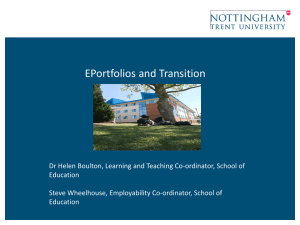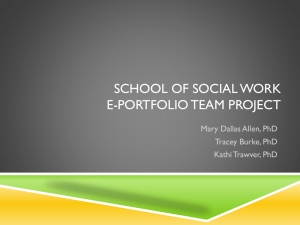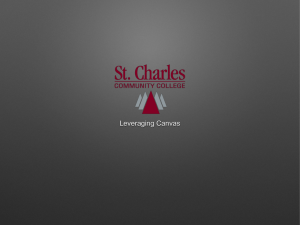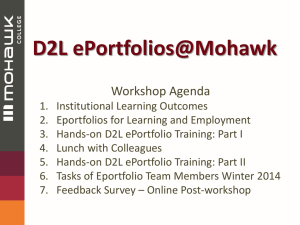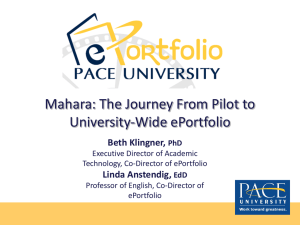2-page proposal file
advertisement
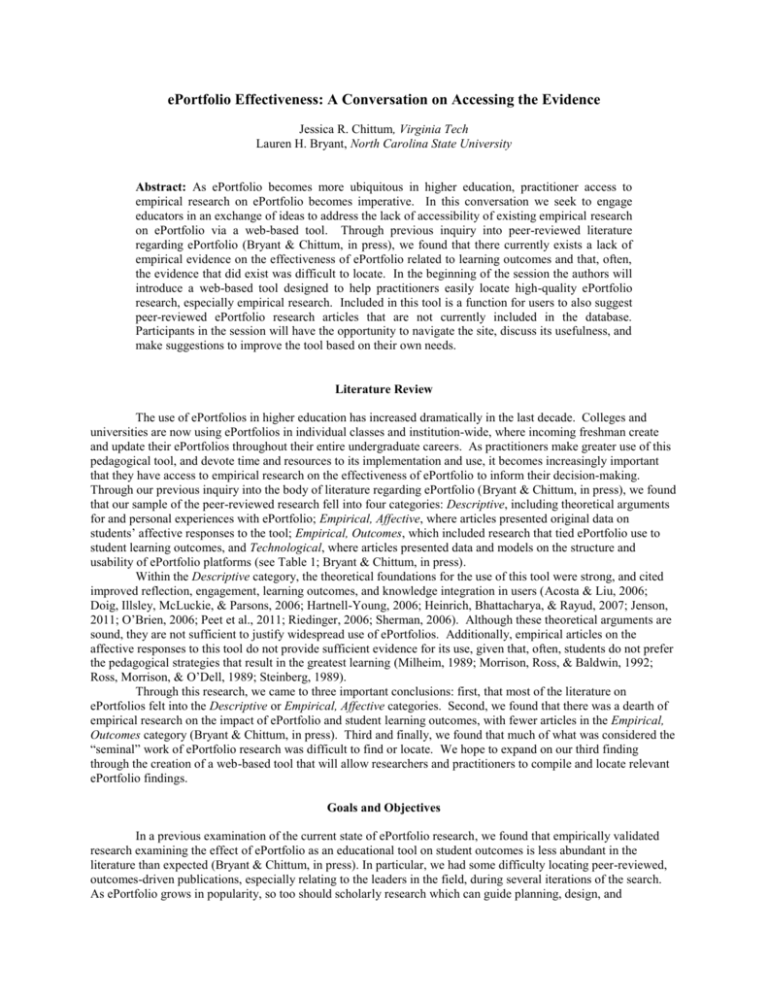
ePortfolio Effectiveness: A Conversation on Accessing the Evidence Jessica R. Chittum, Virginia Tech Lauren H. Bryant, North Carolina State University Abstract: As ePortfolio becomes more ubiquitous in higher education, practitioner access to empirical research on ePortfolio becomes imperative. In this conversation we seek to engage educators in an exchange of ideas to address the lack of accessibility of existing empirical research on ePortfolio via a web-based tool. Through previous inquiry into peer-reviewed literature regarding ePortfolio (Bryant & Chittum, in press), we found that there currently exists a lack of empirical evidence on the effectiveness of ePortfolio related to learning outcomes and that, often, the evidence that did exist was difficult to locate. In the beginning of the session the authors will introduce a web-based tool designed to help practitioners easily locate high-quality ePortfolio research, especially empirical research. Included in this tool is a function for users to also suggest peer-reviewed ePortfolio research articles that are not currently included in the database. Participants in the session will have the opportunity to navigate the site, discuss its usefulness, and make suggestions to improve the tool based on their own needs. Literature Review The use of ePortfolios in higher education has increased dramatically in the last decade. Colleges and universities are now using ePortfolios in individual classes and institution-wide, where incoming freshman create and update their ePortfolios throughout their entire undergraduate careers. As practitioners make greater use of this pedagogical tool, and devote time and resources to its implementation and use, it becomes increasingly important that they have access to empirical research on the effectiveness of ePortfolio to inform their decision-making. Through our previous inquiry into the body of literature regarding ePortfolio (Bryant & Chittum, in press), we found that our sample of the peer-reviewed research fell into four categories: Descriptive, including theoretical arguments for and personal experiences with ePortfolio; Empirical, Affective, where articles presented original data on students’ affective responses to the tool; Empirical, Outcomes, which included research that tied ePortfolio use to student learning outcomes, and Technological, where articles presented data and models on the structure and usability of ePortfolio platforms (see Table 1; Bryant & Chittum, in press). Within the Descriptive category, the theoretical foundations for the use of this tool were strong, and cited improved reflection, engagement, learning outcomes, and knowledge integration in users (Acosta & Liu, 2006; Doig, Illsley, McLuckie, & Parsons, 2006; Hartnell-Young, 2006; Heinrich, Bhattacharya, & Rayud, 2007; Jenson, 2011; O’Brien, 2006; Peet et al., 2011; Riedinger, 2006; Sherman, 2006). Although these theoretical arguments are sound, they are not sufficient to justify widespread use of ePortfolios. Additionally, empirical articles on the affective responses to this tool do not provide sufficient evidence for its use, given that, often, students do not prefer the pedagogical strategies that result in the greatest learning (Milheim, 1989; Morrison, Ross, & Baldwin, 1992; Ross, Morrison, & O’Dell, 1989; Steinberg, 1989). Through this research, we came to three important conclusions: first, that most of the literature on ePortfolios felt into the Descriptive or Empirical, Affective categories. Second, we found that there was a dearth of empirical research on the impact of ePortfolio and student learning outcomes, with fewer articles in the Empirical, Outcomes category (Bryant & Chittum, in press). Third and finally, we found that much of what was considered the “seminal” work of ePortfolio research was difficult to find or locate. We hope to expand on our third finding through the creation of a web-based tool that will allow researchers and practitioners to compile and locate relevant ePortfolio findings. Goals and Objectives In a previous examination of the current state of ePortfolio research, we found that empirically validated research examining the effect of ePortfolio as an educational tool on student outcomes is less abundant in the literature than expected (Bryant & Chittum, in press). In particular, we had some difficulty locating peer-reviewed, outcomes-driven publications, especially relating to the leaders in the field, during several iterations of the search. As ePortfolio grows in popularity, so too should scholarly research which can guide planning, design, and implementation of pedagogy consistent with our institutions’ goals in encouraging Scholarship in Teaching and Learning (SoTL). Through this conversation, we will first describe the difficulties we had in locating peer-reviewed research, followed by a brief overview and conversation concerning the current body of peer-reviewed research updated for 2013 from Bryant and Chittum (in press). Following this, we will display an online resource we developed to meet this need, and enlist the participants’ support in refining the tool in terms of design, content, offered resources, usability, and any additional areas of need and/or resources we have overlooked through a conversation with interested (and perhaps invested) peers. Our guiding question is: “What do you need from this tool?” Our primary objectives include formative feedback and ideas for further development of the online resource, in addition to directions for future scholarly research and web-based endeavors. Description of Topic to be Discussed We plan to begin with an overview of our previous research findings, which will be published in Volume 3, Issue 2 of the International Journal of ePortfolio (see Table 1; Bryant & Chittum, in press). Further, we will discuss changes in these data updated to account for developments in 2013. Our focus during this part of the conversation session will be on our description of this process, including our difficulties in locating the important, seminal (peer reviewed) articles, which will segue into a discussion of an online “tool” we developed to meet that need. Our primary objective is to enlist the participants’ assistance in helping us improve the tool so that it is useful and comprehensive. Table 1 ePortfolio Research Distribution Based on Classification Years 1996-2012 Article Type Descriptive Empirical Total Empirical Affective Outcomes Technological Total (Bryant & Chittum, in press) N 050 058 040 018 010 118 % of Total Sample 042 049 034 015 009 -- % of Type (e.g., empirical) --69 31 --- Analysis of our sample, including a comprehensive list of those peer-reviewed publications we could easily access with resources we believe to be similar to our compatriots in seeking ePortfolio knowledge, makes clear that and increased focus on original data presented in empirically validated research focused on student outcomes is needed. We had particular difficulty locating peer-reviewed sources from the better-known figures in the field. Our search for peer-reviewed and student outcomes-oriented publications was fraught with difficulty, and spanned two years. To alleviate others’ potentially difficult search for the same, we developed a website in which we organized these data and made the resources accessible to a wider audience. Through this conversation session we hope to enlist the help of the participants in perfecting this tool by providing feedback on how they might utilize it and what aspects of the website are still needed or could be improved/modified/removed/added. We will present the website as a “living document,” in that, with the help of the conversation session and website visitors, the database of resources will continue to grow and improve. Facilitation Techniques We will facilitate the discussion by first presenting our experiences (interactive question: “What do you know about ePortfolio?”), research, and an overview of the primary components of our online tool (we will share the link with the group at large for access on personal tablets and laptops during the session), followed by leading questions, including: “What do you need from this tool?” “What is one thing you want that you do not see?” “How could this be improved?” What do you like about this tool?” “Suggestions for applications, organization, technological tools?” Discussion will be open during our initial presentation in that we will welcome others sharing their similar experiences and current research and use of ePortfolio. Depending on the size of the session, we hope to begin with introductions including the following information: name, institution, why I’m here, one adjective I use to describe ePortfolio. We will conclude by passing out information for website access, as well as providing time to address comments we did not discuss post-session. References Bryant, L. H., & Chittum, J. R. (in press). ePortfolio effectiveness: A(n ill-fated) search for empirical support. International Journal of ePortfolio. Manuscript in press. Lombardi, J. (2008). To portfolio or not to portfolio: Helpful or hyped? College Teaching, 56(1), 7-10. Lorenzo, G., & Ittleson, J. (2005). An overview of e-portfolios. EDUCAUSE Learning Initiative, Paper 1. Retrieved from net.educause.edu/ir/library/pdf/eli3001.pdf Acosta, T., & Liu, Y. (2006). ePortfolios: Beyond assessment. In A. Jafari & C. Kaufman (Eds.), Handbook of research on ePortfolios (pp. 15-23). Hershey, PA: Idea Group Reference. Doig, B., Illsley, B., McLuckie, J., & Parsons, R. (2006). Using eportfolios to enhance reflective learning and development. In A. Jafari & C. Kaufman (Eds.), Handbook of research on eportfolios (pp. 158-167). Hershey, PA: Idea Group. Hartnell-Young, E. (2006). ePortfolios in Australian schools: Supporting learners’ self-esteem, multiliteracies and reflection on learning. Informatics Education – The Bridge Between Using and Understanding Computers, 4226, 279-289. Heinrich, E., Bhattacharya, M., & Rayudu, R. (2007). Preparation for lifelong learning using ePortfolios. European Journal of Engineering Education, 32(6), 653-663. Jenson, J. (2011). Promoting self-regulation and critical reflection through writing students’ use of electronic portfolio. International Journal of ePortfolio, 1(1), 49-60. Milheim, W. D. (1989). Perceived attitudinal effects of various types of learner control in an interactive video session. Proceedings of the Annual Meeting of the Association for Educational Communications and Technology, USA, 301-318. Morrison, G., Ross, M., & Baldwin, W. (1992). Learner control of context and instructional support in learning elementary school mathematics. Educational Technology Research and Development, 40(1), 5-13. doi:10.1007/BF02296701 O’Brien, K. (2006). ePortfolios as learning construction zones: Provost’s perspective. In A. Jafari & C. Kaufman (Eds.), Handbook of research on ePortfolios (pp. 74-89). London, UK: Idea Group. doi:10.4018/978-159140-890-1.ch008 Peet, M., Lonn, S., Gurin, P., Boyer, K., Matney, M., Marra, T., . . . Daley, A. (2011). Fostering integrative knowledge through ePortfolios. International Journal of ePortfolio, 1(1), 11-31. Riedinger, B. (2006). Mining for meaning: Teaching students how to reflect. In A. Jafari & C. Kaufman (Eds.), Handbook of research on eportfolios (pp. 90-101). London, UK: Idea Group. doi:10.4018/978-1-59140890-1.ch010 Ross, S., Morrison, G., & O’Dell, J. (1989). Uses and effects of learner control of context and instructional support in computer-based instruction. Educational Technology Research and Development, 37(4), 29-39. Steinberg, E. (1989). Cognition and learner control: A literature review. Journal of Computer-Based Instruction, 16(4), 117-121.
